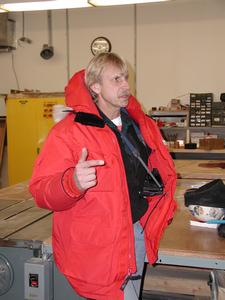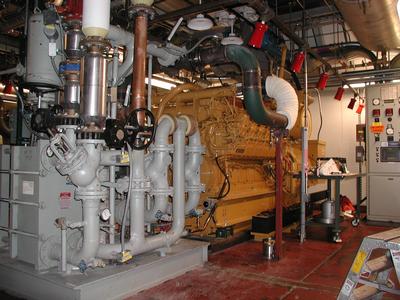2 December, 2001
Most of the people working at the South Pole get one day off a week. Since the detector we were working on had passed the light test, we decided to reward ourselves with a day of rest also. Jerry Martin, the National Science Foundation (NSF) Station Manager, invited a few of us on a tour of the new station that is under construction.
The original South Pole Station was constructed in the late 1950's. However, it quickly lost its battle to the drifting snow and is now completely buried under snow and is nothing more than a memory for those that were stationed there. The station I am currently working in, was opened in 1975. It's most well known symbol is the aluminum geodesic dome, 165 feet in diameter at the base and 55 feet at its apex. The dome houses three two-story structures that contain living, dining, communications, recreation, laboratory, and meeting facilities. This station was originally designed to accommodate 27 people and have a lifespan of 25 years. This famous South Pole Station has exceeded the expectations of the designers. However, it is losing its battle of staying above the snow, and within a few years will be completely buried.
The increase in population and outdated facilities, mandated a new station be built. The dome will soon be replaced by a 60,000 square foot elevated station. This station will have a projected lifespan of 45 years. Since the snow is always accumulating, the station is designed to be elevated an additional 12 feet in 25 years, followed by another 12 feet a decade later.
The first section of the new elevated station is already in place. Jerry walked us through the construction site to explain what this state of the art facility will look like. The housing areas will be similar to college dormatories and the science areas will be extremely high-tech. The expected date of completion will be in 2006. However, the new station will become functional almost immediately. There are plans to have the winter over crew stay here this winter. The new station will be a welcome site to those wintering over becuase it was designed so all operations can be done without having to go outside, where temperatures often exceed -100 F during the winter months.
Today the South Pole received its first tourists of the season. A DC-3 landed at the South Pole at 9:30 in the morning. The purpose of the flight was to commerate the anniversary of Admiral Byrd's flight over the South Pole in 1929. The tourists stayed only a few short hours, using their time to take their pictures at the pole marker.
When tourists visit the South Pole, the station manager has to be very cautious of their safety. One accident can seriously undermine the science research being conducted and strain already limited medical supplies. For this reason, tourists are greeted by an offical host who guides them carefully around the sites. The number one problem that tourists encounter is fainting from the low oxygen levels. No tourists ever stay overnight at the South Pole, for there is no room. People who arrive at the pole from overland on expeditions, have to stay in tents in a little area that is groomed near the pole marker. The tourists were welcomed by all, but they eventually left and work resumed.
In the afternoon, those of us stationed here were entertained by guitarist Henry Keiser. Each year, the NSF sends artists and writers to Antarctica. The purpose of the Artist/Writers Program is allow others to experience Antarctica's lure. An example of how this program allows others to experience Antarctica is Sara Wheeler's book 'Tera Incognita'. She does a wonderful job depicting life in Antarctic Stations. With this in mind, I am going to now head to my dorm to read a little...something I have not done since arriving at the pole.
Biological Data
Saturated Oxygen: 94%
Pulse Rate: 81
Weather Data
Temperature: -26.6 F
Wind Chill: -53.1 F

Jerry Martin explaining the logistics of construction at the South Pole.

The DC-3 that brought the tourists to the South Pole.

One of three generators that supply power to the station.

The half snow covered dome viewed from the new elevated station.
Contact the TEA in the field at
.
If you cannot connect through your browser, copy the
TEA's e-mail address in the "To:" line of
your favorite e-mail package.
|
